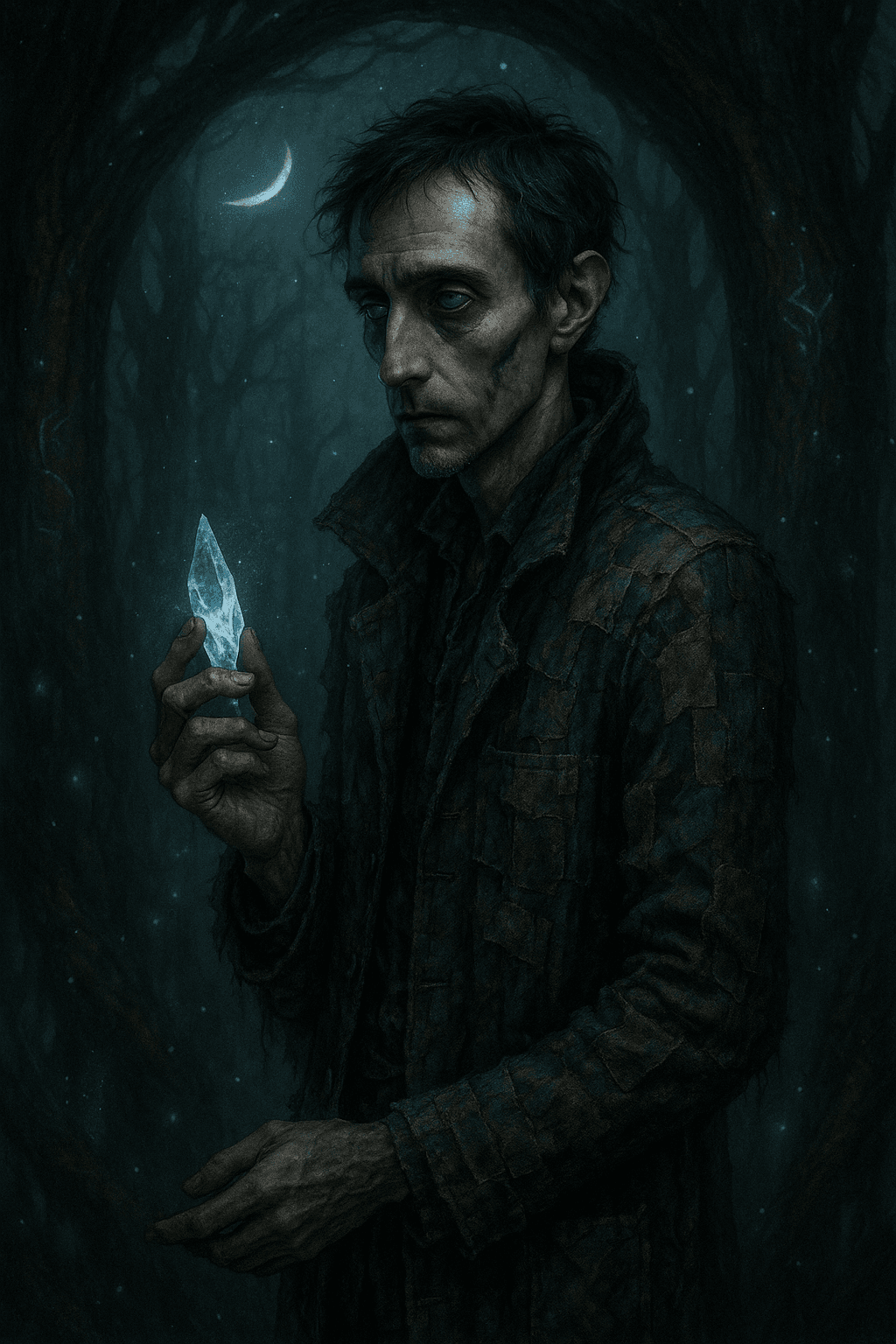Velk the Hollow
What is missing makes room for truth.

They call him Velk because names need somewhere to live, even in a man where most of the furniture has been taken out. The people of Hollowroot say he was once ordinary—voice, memories, a spine that bent toward the fire when nights ran cold. Now he moves like a draft through a shut room, and when he speaks the words seem to arrive already faded, as if you are remembering them instead of hearing them. In Duskfall Mire, that kind of absence has a purpose.
Twilight.
When the mists grew thick enough to carry meanings of their own, Nightshade Weaver and the council of the Whispering Bloom began sending feelers into the oldest parts of the mire: sinkholes where sound went wrong, drowned archives bound in root, places the Memory Drakes circled but would not land. Velk the Hollow was their favorite tool for such errands. Tools, after all, are safer when they don’t ask what they’re building.
He wears a coat sewn from dreamweave scraps the Bloom salvaged from moon-wet nets—fabric that forgets the shape of knives. His eyes are the part strangers fear: not empty, exactly, but busy with something you can’t see, as if he is reading notes written behind your face. He dislikes lanterns. He prefers the quiet glow of lichen and the cold blessing of the crescent moon, which lights only what agrees to be seen.
Velk’s craft is listening. Not to voices, not at first, but to the pauses between them. He takes a stool in a doorway and lets the room talk around him. He hums in harmony with the canal water until its currents remember the last boat that passed. He holds a shard from a Memory Drake’s shed crystal to his temple and waits until the static becomes a single, usable thread. The Bloom values results more than methods; Velk rarely writes reports. He brings a key no one admits they misplaced, a map drawn in mildew on the underside of a plank, the true name of a thorn hedge that has stood since before records. “You retrieved this from whom?” agents ask. “From where it was left,” he answers, and the conversation ends there.
In the council chamber—a cathedral of roots woven into a dome—Nightshade Weaver lets him stand in the shadow of the sigil-lantern rather than at the table. The arrangement suits them both. Velk has no talent for the Bloom’s elaborate rhetoric. He states facts and waits. When questioned about his loyalties he smiles like someone invited to sit in a chair that isn’t there, then remains standing. The Bloom is pragmatic; reliability counts for more than charm. Velk delivers.
Some say he was remade by the mists—a Lost One pared down until only the faculty of finding remained. Others say he made a covenant with a drowned archive to carry its silence in exchange for safe passage. Velk never confirms a story. He cares whether a story works.
He has odd kindnesses. Children who stray into the fog come back with their pockets full of polished seeds and a sense that they must not tell anyone who found them. He talks to Duskwyrms in a voice so thin the fog uses it as thread; the drakes answer with a single breath that dims lantern-light but leaves the small lights of fungus undisturbed. In Hollowroot’s market, he touches wares with gloved fingers and buys only what was not meant to be sold—broken watch-chains, chipped cups, the last onion in a basket. When asked why, he says, “Ends must end somewhere. I prefer to know where.”
Yet there is steel in him. When Bloom defectors began spreading a clever kind of madness—a story that told itself into other stories until it ate the teller—Velk walked alone into the alley where the rumor nested. He returned with a smear of shadow across his cheek and one phrase: “The motif is hunger.” The Bloom altered their wards accordingly and the epidemic stopped nearer its beginning than anyone expected. Velk kept the shadow-mark. He said it helped with eavesdropping.
He has an ongoing feud with quilts of Thornspine quills set along the borders of Galdrowen. Their low hum bothers a part of him that navigates by absence; the sound is too much presence, too much “no.” The few times he has had to cross those lines for Bloom work, he did it swiftly and with visible discomfort, as if passing beneath a bell. “The forest sings in declaratives,” he muttered afterward, and refused to elaborate.
If Nightshade Weaver is a loom pulling threads into patterns, Velk the Hollow is the space the loom requires—the slack that lets patterns be tied without knotting. He is not the point of the Whispering Bloom. He is how the point arrives where it needs to be. In a season when truths are bartered like weapons, he collects the kind that can’t be traded: truths that sit at the bottom of wells and wait for a face to lean over and look.
Given a choice, he would not be famous. He prefers his name said by those who whisper. But in the Mire, when the mists rise and a problem appears that sounds like nothing anyone has heard before, someone always says, “Find Velk.” And the problem, hearing its proper adversary named, begins to feel less certain of itself.
